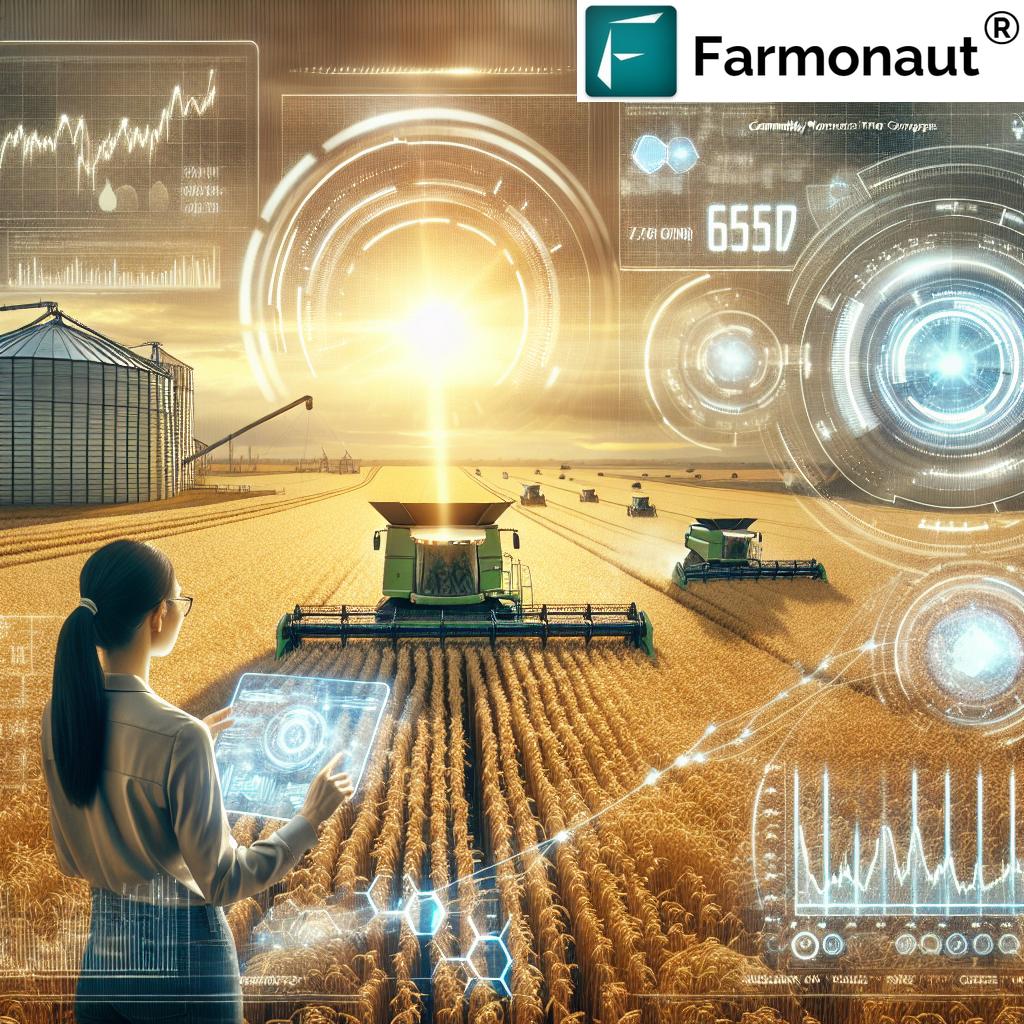Mastering Agricultural Futures: Farmonaut’s Guide to Precision Farming and Risk Management Strategies
“Agricultural futures trading accounts for over 10% of global commodity market volume, with wheat being a top-traded crop.”
In today’s dynamic agricultural landscape, mastering the art of futures trading and risk management is crucial for farmers, traders, and agribusinesses alike. At Farmonaut, we understand the intricate relationship between precision farming techniques and effective risk management strategies in the agricultural derivatives market. This comprehensive guide will explore the world of agricultural futures, offering insights into crop price hedging strategies, innovative agritech market data analytics, and the revolutionary impact of precision agriculture technology on farm risk management solutions.
Understanding Agricultural Futures and Their Importance
Agricultural futures contracts are standardized agreements to buy or sell a specific quantity of an agricultural commodity at a predetermined price on a future date. These financial instruments play a vital role in the global agricultural economy, offering several benefits:
- Price discovery
- Risk management
- Market efficiency
- Liquidity for producers and consumers
As we delve deeper into the world of agricultural futures, it’s essential to understand how these contracts function within the broader context of commodity trading and risk management.
The Role of Precision Agriculture in Risk Management
Precision agriculture technology has revolutionized the way farmers approach risk management. By leveraging advanced satellite imagery, AI-driven analytics, and real-time data, precision farming tools enable more accurate decision-making and resource allocation. Here’s how precision agriculture contributes to effective risk management:
- Enhanced crop yield forecasting
- Improved resource management
- Early detection of crop health issues
- Optimized irrigation and fertilization strategies
At Farmonaut, we offer cutting-edge precision agriculture solutions that empower farmers to make data-driven decisions, ultimately reducing risks and improving profitability.

Exploring Agricultural Commodity Trading Strategies
Successful agricultural commodity trading requires a deep understanding of market dynamics, technical analysis, and fundamental factors affecting crop prices. Let’s explore some key strategies for trading agricultural futures:
- Trend Following: Capitalize on long-term price movements in agricultural commodities.
- Spread Trading: Exploit price differentials between related agricultural futures contracts.
- Options Strategies: Use options to hedge against price volatility or generate income.
- Seasonal Trading: Take advantage of recurring price patterns in agricultural markets.
Implementing these strategies effectively requires access to real-time market data, historical price information, and advanced analytical tools. Farmonaut’s platform provides traders with the necessary resources to refine their trading strategies and make informed decisions.
Crop Price Hedging Strategies for Farmers
For farmers, managing price risk is crucial to ensuring financial stability and long-term success. Here are some effective crop price hedging strategies:
- Forward Contracts: Lock in a future selling price for crops before harvest.
- Futures Hedging: Use futures contracts to protect against adverse price movements.
- Options Hedging: Purchase put options to establish a price floor for crops.
- Basis Contracts: Lock in the basis (difference between cash and futures prices) while leaving the futures price open.
By implementing these strategies, farmers can mitigate the impact of price volatility on their operations and ensure more stable income streams.
Leveraging Agritech Market Data Analytics
In today’s data-driven agricultural landscape, access to accurate and timely market information is crucial for success. Agritech market data analytics provide valuable insights that can inform trading decisions, risk management strategies, and overall farm management practices. Key areas of focus include:
- Supply and demand forecasts
- Weather pattern analysis
- Price trend predictions
- Global trade flow monitoring
Farmonaut’s platform integrates advanced agritech market data analytics, empowering users with the information they need to navigate complex agricultural markets successfully.
The Impact of Precision Agriculture on Farm Risk Management
“Precision agriculture technology has increased crop yield forecasting accuracy by up to 30% in the last decade.”
Precision agriculture has transformed farm risk management by providing farmers with unprecedented insights into their operations. Here’s how precision farming technology is revolutionizing risk management in agriculture:
- Improved Crop Monitoring: Satellite-based crop health monitoring allows for early detection of issues, reducing the risk of crop failure.
- Optimized Resource Allocation: Data-driven insights enable more efficient use of water, fertilizers, and other inputs, lowering production costs and environmental impact.
- Enhanced Weather Forecasting: Advanced weather modeling helps farmers prepare for and mitigate the effects of adverse weather conditions.
- Precise Yield Forecasting: Accurate yield predictions allow for better financial planning and risk management strategies.
At Farmonaut, we’re committed to making precision agriculture technology accessible to farmers of all sizes, helping them implement effective risk management solutions.
Understanding Agricultural Futures Contracts
To effectively trade and manage risk in agricultural markets, it’s essential to understand the nuances of agricultural futures contracts. Let’s explore some key aspects:
| Commodity Type | Contract Specifications | Average Historical Volatility (%) | Typical Margin Requirements (%) | Major Trading Exchanges | Risk Management Strategies | Precision Agriculture Applications |
|---|---|---|---|---|---|---|
| Wheat | 5,000 bushels, Mar, May, Jul, Sep, Dec | 25-30 | 5-10 | CBOT, KCBT | Hedging, Options | Yield forecasting, Soil moisture monitoring |
| Corn | 5,000 bushels, Mar, May, Jul, Sep, Dec | 20-25 | 4-8 | CBOT | Spread trading, Futures hedging | Nitrogen management, Pest detection |
| Soybeans | 5,000 bushels, Jan, Mar, May, Jul, Aug, Sep, Nov | 20-25 | 5-10 | CBOT | Options strategies, Basis trading | Crop health monitoring, Irrigation optimization |
| Cotton | 50,000 pounds, Mar, May, Jul, Oct, Dec | 25-30 | 6-12 | ICE | Forward contracts, Options hedging | Fiber quality prediction, Growth stage monitoring |
| Coffee | 37,500 pounds, Mar, May, Jul, Sep, Dec | 30-35 | 8-15 | ICE | Seasonal trading, Futures hedging | Disease detection, Harvest timing optimization |
This comparison matrix provides a clear overview of various agricultural futures contracts, helping traders and farmers make informed decisions about risk management strategies and precision agriculture applications.
Innovative Tools for Agricultural Futures Trading
The agricultural futures market has evolved significantly with the advent of advanced technology. Here are some innovative tools that traders and risk managers can leverage:
- AI-Powered Market Analysis: Machine learning algorithms that predict price movements based on historical data and current market conditions.
- Blockchain-Based Traceability: Enhancing transparency in agricultural supply chains, potentially impacting futures prices.
- Satellite-Based Crop Monitoring: Real-time insights into global crop conditions, influencing supply forecasts and futures prices.
- Automated Trading Systems: Algorithmic trading strategies that execute trades based on predefined parameters and market conditions.
Farmonaut’s platform integrates many of these innovative tools, providing users with a comprehensive suite of resources for effective agricultural futures trading and risk management.

Risk Management Solutions for Agribusinesses
Agribusinesses face unique challenges when it comes to risk management. Here are some effective solutions:
- Portfolio Diversification: Spread risk across multiple commodities and markets.
- Customized Hedging Strategies: Tailor risk management approaches to specific business needs.
- Weather Derivatives: Hedge against adverse weather conditions that can impact crop yields.
- Supply Chain Risk Management: Implement strategies to mitigate risks throughout the agricultural supply chain.
By implementing these solutions, agribusinesses can better navigate the volatile agricultural marketplace and ensure long-term stability.
The Role of Data in Agricultural Futures Trading
Access to accurate and timely data is crucial for success in agricultural futures trading. Here’s how different types of data contribute to effective trading and risk management strategies:
- Historical Price Data: Essential for identifying trends and patterns in agricultural commodity markets.
- Real-Time Market Data: Enables traders to make quick decisions based on current market conditions.
- Weather Data: Crucial for predicting crop yields and potential supply disruptions.
- Economic Indicators: Helps traders understand broader market trends that may impact agricultural futures prices.
Farmonaut’s platform provides access to comprehensive datasets, empowering users to make data-driven decisions in their agricultural futures trading activities.
Navigating Regulatory Challenges in Agricultural Futures Trading
Agricultural futures trading is subject to various regulations designed to ensure market integrity and protect participants. Key regulatory considerations include:
- Position limits
- Margin requirements
- Reporting obligations
- Anti-manipulation rules
Staying informed about regulatory changes and ensuring compliance is crucial for success in agricultural futures trading. Farmonaut’s platform helps users navigate these regulatory challenges by providing up-to-date information and tools for efficient compliance management.
The Future of Agricultural Futures Trading
As we look ahead, several trends are shaping the future of agricultural futures trading:
- Increased Integration of AI and Machine Learning: More sophisticated predictive models and automated trading strategies.
- Growing Importance of Sustainability: Environmental, Social, and Governance (ESG) factors influencing agricultural futures markets.
- Expansion of Blockchain Technology: Enhanced transparency and efficiency in agricultural supply chains and futures trading.
- Rise of Alternative Data Sources: Satellite imagery, IoT sensors, and social media sentiment analysis providing new insights for traders.
At Farmonaut, we’re committed to staying at the forefront of these trends, continually innovating our platform to provide users with cutting-edge tools for agricultural futures trading and risk management.
Leveraging Farmonaut’s Platform for Agricultural Futures Trading
Farmonaut’s comprehensive platform offers a range of tools and resources specifically designed for agricultural futures trading and risk management:
- Satellite-Based Crop Monitoring: Real-time insights into crop health and potential yield forecasts.
- AI-Powered Advisory System: Personalized recommendations for trading and risk management strategies.
- Blockchain-Based Traceability: Enhanced transparency in agricultural supply chains, impacting futures price dynamics.
- Advanced Analytics Dashboard: Comprehensive market data and analysis tools for informed decision-making.
By leveraging these tools, traders and farmers can gain a competitive edge in the agricultural futures market while effectively managing risks.
Conclusion: Mastering Agricultural Futures with Precision Farming
In today’s dynamic agricultural marketplace, success in futures trading and risk management requires a combination of market knowledge, technological innovation, and data-driven insights. By leveraging precision farming techniques and advanced analytics, traders and farmers can navigate the complexities of agricultural futures markets with greater confidence and efficiency.
Farmonaut’s comprehensive platform offers the tools and resources necessary to thrive in this evolving landscape. From satellite-based crop monitoring to AI-powered market analysis, our solutions empower users to make informed decisions, manage risks effectively, and capitalize on opportunities in the agricultural futures market.
As we look to the future, the integration of precision agriculture technology with traditional futures trading strategies will continue to reshape the agricultural sector. By staying informed, embracing innovation, and leveraging platforms like Farmonaut, stakeholders across the agricultural value chain can position themselves for long-term success in an increasingly data-driven world.
FAQ Section
Q: What are agricultural futures contracts?
A: Agricultural futures contracts are standardized agreements to buy or sell a specific quantity of an agricultural commodity at a predetermined price on a future date. They are used for price discovery, risk management, and hedging in agricultural markets.
Q: How does precision agriculture contribute to risk management in futures trading?
A: Precision agriculture provides accurate, real-time data on crop health, yield forecasts, and resource management. This information helps traders and farmers make more informed decisions about futures positions and hedging strategies, ultimately reducing risk.
Q: What are some common hedging strategies for farmers using futures contracts?
A: Common hedging strategies include selling futures contracts to lock in prices for upcoming harvests, using options to establish price floors, and employing spread trading to manage basis risk.
Q: How does Farmonaut’s platform assist in agricultural futures trading?
A: Farmonaut’s platform offers satellite-based crop monitoring, AI-powered market analysis, and comprehensive data analytics tools. These features help users make informed trading decisions, manage risks effectively, and optimize their agricultural operations.
Q: What role does blockchain technology play in agricultural futures trading?
A: Blockchain technology enhances transparency and traceability in agricultural supply chains. This increased visibility can impact futures prices and trading strategies by providing more accurate information about supply and demand dynamics.
Ready to revolutionize your approach to agricultural futures trading and risk management? Explore Farmonaut’s cutting-edge solutions today:






